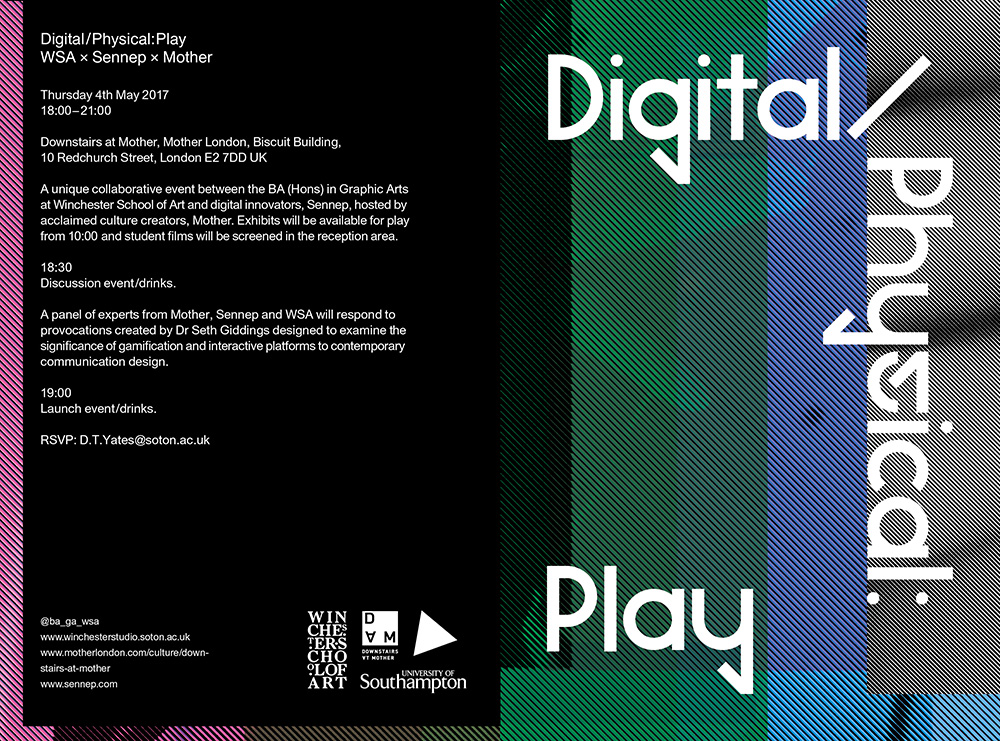On the 4th May 2017, I was invited to participate in a very insightful discussion at Mother, in London. The event was organised by Derek Yates, from WSA, Mother and Sennep. Dr. Seth Gidings was chairing the sessions and the panel was composed of: Derek Yates, Jaygo Bloom, Adam Procter, Vanissa Wanick (me! yay!), Carleigh Morgan, Bobbie Allsop, Mink Ette, Sennep. All super designers and thinkers! We received an email with some really difficult questions and I would like to share with you my thoughts and ideas :) Here it goes!
1. Ask each speaker to introduce her or himself, and to succinctly complete the following phrase: ‘Exploring the playful relationship between the physical and the digital is important to me because….’
I’m Vanissa Wanick, Brazilian UX designer and now PhD in games design from Winchester School of Art, with a thesis in advergames across cultures. And ‘Exploring the playful relationship between the physical and the digital is important to me because….’Because the physical and the digital are always in conversation and it is very difficult to find boundaries between each other. It is important because we are changing our relationship with both physical and digital and they are becoming one thing. Thus, imagine that as a child you could play with spaces and anything could become a “toy”. Now this extends to the digital; children swipe paper thinking that it would function just like a tablet. I’ve seen kinds swiping a TV thinking that it was a huge iPad.
2. Communication design is generally understood as underpinned by storytelling. What are the implications for your ideas and practice in a digital environment in which narrative is opened up and transformed by games and play? What is the role of the creative practitioner in designing or managing the open-ended, social, collaborative and emergent possibilities of playful user experience? What kinds of control do you want to keep, and what are you willing to cede to the player?
A vey huge question. I think it is hard to keep control – or maybe we need to define control in this digital environment. In the case of games, as designers, we have a huge responsibility, since people could change their behaviours by interacting with games. However, there is another side of the coin – games function like a conversation. It is difficult to predict how the player will react, since we are not designing an experience, but we are creating interactions, possibilities. However, since we started the conversation, it is possible that as designers we could function as guides, or as scientists. Who knows? As for the narrative, I think it is all transmedia, it is everywhere and it is how we communicate anyway.
3. Play is celebrated for its creative potential – it is seen as open, free, social, imaginative, emergent, and even subversive or transgressive. What are the ethical and political implications of deploying games and playful digital technologies for commercial ends: to attract and retain consumers’ attention, to data mine and track movement on and offline, to gamify everyday life?
Wow, that’s a big challenge. First, can we gamify everything? If so, do we need to gamify everything? Why transforming everything into a game? Playing a game is not trivial – it is hard and that’s why it is fun. So it is not because it is easy that it is fun. Another thing is the data mining and data economy. This is everywhere and people can’t hide. Of course, brands can access all these data, which could emerge from interactions with playful and gameful environments and influence people’s minds. One thing to think again is the responsibility that we have as designers. Research has shown that children can’t identify a persuasive content (e.g. advertising) in games. Thus, they think it is fun playing with M&Ms or whatever the product – but in that case they can’t see as advertising strategy. Also, games can function as transgressive and subversive. I’m quite interested in subversive mechanics, in which you actually don’t win – you never win and you keep playing – or you use other political elements in the game to make people question some aspects. Newsgames and critical play are there. I think there is a lot to think. I also think that we should consider values in games and this should be one topic to take into account while designing games.
And that was it! Not sure if you agree with me or if you have anything else to add, but please feel free! :)
Until the next event!
References:
Digital/ Physical: PLAY
The Internet of Toys: Implications of increased connectivity and convergence of physical and digital play in young children
Digital/ Physical: Play from Curtis Rayment on Vimeo.
